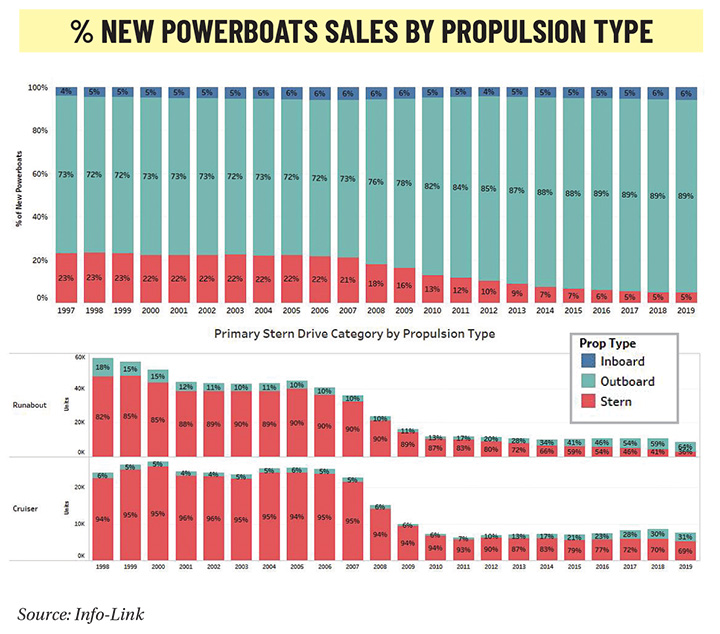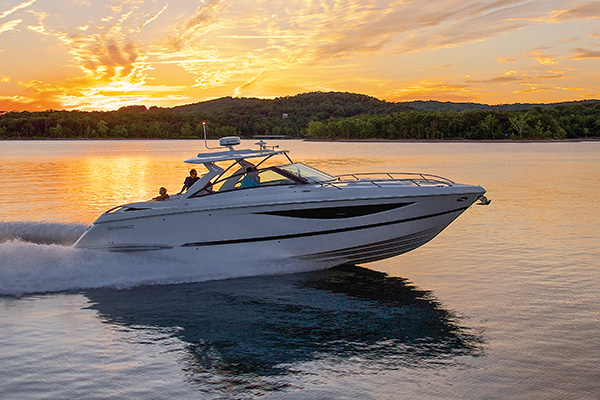The sterndrive story: What lies beneath the surface

By David Gee
To paraphrase something Mark Twain may – or may not – have once said: The rumors of the death of the sterndrive are greatly exaggerated.
Now before we get a bunch of angry emails asking who in fact declared the category dead, the answer is no one. Not today. Maybe not ever. Though it’s a fact that sales have decreased to just a fraction of what they once were (more on that later), it’s also a fact that sterndrives are still a viable part of the recreational boating industry ecosystem.
Sterndrive sentiments
“The sterndrive remains an attractive option for customers and OEMs,” said Ron Huibers, president and CEO of Volvo Penta of the Americas. “In some cases, it’s even the best option. The vast majority of the boating in this country is done on inland lakes and sterndrives work really well there for lots of reasons.”
“For us the sterndrive is an absolute must,” echoed Paul Ray, president, Ilmor Engineering. “We think the sterndrive system provides a superior package. We’ve always liked it, including the idea of the engine and drive package being integrated into the boat, out of sight and out of the way. It’s very automotive-like if you will, in terms of the entire powertrain integration.”
Huibers went on to say that one of the issues with sterndrives is that lots of people have very outdated opinions of them based on some poor, underperforming products from decades ago.
I put myself in that category. Back when I was a kid my parents “upgraded” from a 16-foot Larson runabout with a 90-horsepower Mercury on the back, to a larger, fancier sterndrive, with a clunky shifter and no torque. It took about a football field for the average person to get up on a single slalom ski and you risked ingesting about half of the lake in the process.
“Let’s be clear,” Huibers said adamantly. “We have reinvented the sterndrive since then. What we produce today is simply a long ways from the cheap, four-cylinder sterndrive of the past.”

Improvements and iterations
When Volvo Penta introduced the Aquamatic drive in 1959, it combined the benefits of inboard and outboard engines and provided excellent performance for the time.
There have been lots of improvements and iterations since then obviously, including the introduction of the Duoprop in 1982; two counter-rotating propellers that together improve handling and grip.
Now you can add to the list easier maintenance, longer service intervals, greater reliability and enhanced performance through such features as a hydraulic clutch that makes for silent and smooth shifting.
“The hydraulic clutch, together with electric steering, not only makes for an enhanced feel, but it also gives improved joystick docking functionality,” says Huibers. “It also enables our dynamic positioning system to be introduced, which automatically maintains a boat’s heading and position, even during strong currents or windy conditions.”
Ilmor also has the smooth shift technology, along with the virtual anchor assist, planing assist, and other features. But Ray says there has also been development in the engine bay itself.
“We have GM’s latest and greatest Generation 5 engines, using a trio of Next-Gen technologies, including direct injection, active fuel management and variable valve timing. This delivers more power with greater efficiency. In conjunction with more sophisticated electronics from GM and from us, this just really brings forward what was aging technology. I think people realize how much sterndrives have evolved and improved. And if they don’t, a quick demo in one will make it clear.”
Ray also says they hear from customers quite frequently that they find sterndrives aesthetically pleasing. And functional.
“When you look at studies of how people use their boats, and watch them on the water, one of the things they spend a lot of time doing is rafting up with other boats. When you do that everyone is going to be hanging out on the back of the boat, right? You have these wonderful swim platforms and aft seating areas that you simply can’t enjoy with a bunch of outboards and the accompanying rigging tied to the back. The sterndrive layout really allows you to enjoy the boat to a far greater degree.”
Emissions and corrosion
And there is the emission issue. Ray notes that all but a few large outboard engines built for sale in the U.S. in 2018 or later are 3-Star CARB rated. They are the most fuel-efficient outboard engines ever built for the mass market.

“However, in 2016, Ilmor began production on the GDI engine series, the only production marine gasoline engines to achieve a 5-star emissions rating from CARB. Not many people talk about that, but it just shows the technology in the sterndrive market.”
Technology has also improved corrosion protection – especially in the saltwater environment – for sterndrives.
“There’s no doubt earlier closed-cooled sterndrives suffered terribly from corrosion,” admitted Ray. “We listened to that and came up with a closed-cool exhaust system where our exhaust is filled with glycol and isn’t exposed to the saltwater in critical areas. Now we even have started offering a seven-year warranty. That’s how much we believe in that. So you can have a successful sterndrive experience in saltwater.”
All of those things sound good. The sterndrive is still attracting dollars, energy, bandwidth and attention. It’s a large part of the installed base of the recreational boating industry fleet in this country, and there are lots of sterndrive units in circulation.
The numbers
So why have the number of sterndrive-equipped new boats been going down for some time?
“It’s kind of been experiencing a double whammy,” explains Peter Houseworth, director of client services at marine services research firm Info-Link. “The traditional sterndrive market was in smaller, lower-priced runabouts of 16-18 feet, up to about 24-feet. That end of the market never really recovered from the 2008 recession and has declined even further since.
“Additionally, that smaller sterndrive boat was primarily the entry-level product for people new to boating. And as we all know, the number of new boaters has also been in decline.”
Houseworth says manufacturers have migrated to outboards in these smaller boats as well, so that has further impacted sterndrive unit sales.
“I certainly don’t think the sterndrive market is going away, but there is no doubt the best years are in the rearview mirror in my opinion.”

Looking ahead
Both Huibers and Ray are still optimistic though.
“The future? There is absolutely no reason for the sterndrive to go away,” Ray said in closing. “Our competitors are improving their products. We’re improving ours. I think sterndrive has a very bright future.”
“I’m not trying to tell you the marketplace is wrong. What I am telling you is we continue to improve the sterndrive immensely,” said Huibers. “We are still putting money into the segment. For example, we have some patents for a surfable, sterndrive pontoon boat that we think has the potential to be huge. There are pendulum swings in this business, so who knows what the future will bring? But when you ask today’s sterndrive customer about their boats they are very happy with them.”





The sterndrive market is truly hurting in my industry. Houseboat builders are hurting and part of that is the high cost of engine and generator packages. I believe a lot of the blame falls on federal emission standards driving the cost of sterndrive engines so high. The engine today are aluminum to lower weight. Most, but not all sterndrive engines are based on auto engine blocks, must be close cooled to help reduce corrosion,this also drives up cost due to heat exchangers and catalyst style manifold.